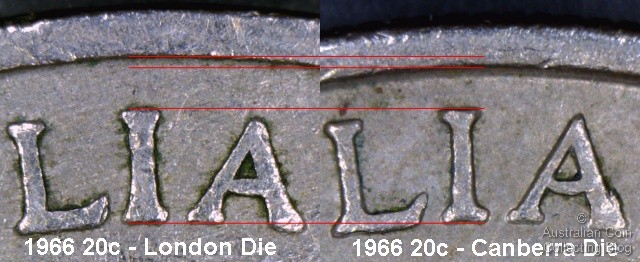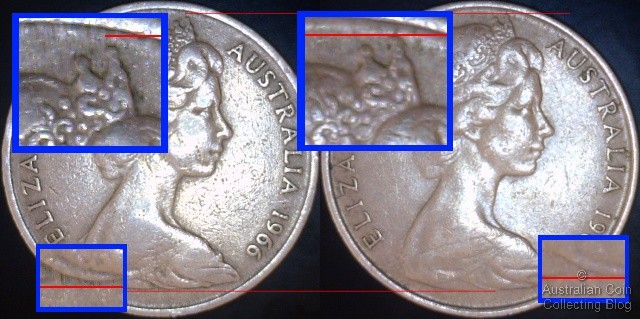A well known Australian decimal variety expert mentioned recently on the Australian Coin and Banknote Forum* that not only does the reverse of the 1966 20c coin show distinct mint marks, but also the obverse die shows differences between coins minted in London and those minted in Canberra. Immediately thinking, here’s an opportunity to make use of our new Dino-Lite USB Microscope we thought we’d take a look at this. Unfortunately the author of this entry only had several low grade London and Canberra 1966 20c coins to work with so the investigation was confined to comparing the size of features on the obverse of the coin. We plan, at a later date, to image high grade coins from both mints to see if there are any die feature differences between the two mints.
Firstly, it is apparent that Canberra minted coins have slightly thinner obverse rims and the lettering of the legends is closer to the rim. This is shown clearly in the image below:
You can see a detailed micrograph of the LIA of Australia with the London minted 1966 20c coin on the left, and the Canberra coin on the right. The lettering is noticeably closer to the edge on the Canberra coin. The next task was to look at the size of HM’s portrait to determine if the lettering was simply spaced differently on the two dies or to determine if the die on the London coins was a ‘small obverse’ and that on the Canberra coins a ‘large obverse’. You can see the results below (including magnified cut-outs to show detail).
It is readily apparent that the portrait of the London minted coins is significantly smaller than that of the Canberra minted coins. One can only wonder how this could have happened. For a difference in the size of the dies use to produced the machines one would think that an (ever so slightly) different reduction ratio was used on the reduction lathe which is used to produce master steel dies from the relief model of the coin design. These master dies are used to produce working hobs which in turn would have been used to produce the working dies that actually minted the coins.
We’ll be doing some further research into this to try to shed some more light on the subject. Stay tuned.



